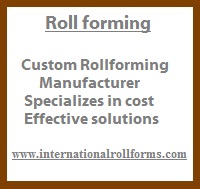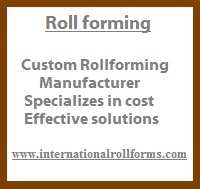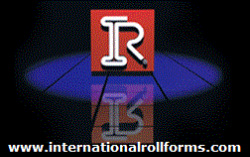 _ Roll forming is a process that forms a continuous metal strip with roller dies that mold it into the desired shape. The parts that have been roll formed can have a variety of shapes, angles, and curves. It can be used to form all kinds of ferrous and nonferrous metals. The ability to roll form different types of metals allows manufacturers to have multiple options to design products that best fit specific needs. Certain design changes may strengthen and improve the functionality of the roll formed parts. It allows a number of other processes to be performed while the material is being formed.
Roll forming machines can produce many cross section profiles. However, they require a crafted set of roll tools for that. The materials that are designed are not heavy yet extremely strong. Finishing or paint is not necessary for these products. These kinds of machines can process in a number of methods. These processes include flat rolling, ring rolling, foil rolling, controlled rolling and roll bending. They are also used to minimize the usage of a new set of roll for producing similar materials like track profiles and studs.
Many different types of materials are used in the process. It is possible to manufacture a wide variety of roll formed parts and shapes. A majority of metals that exist can be roll formed. Complex parts and shapes can be made from basic cold roll steel to per-coated material to vinyl-laminated material with minimal complications to worry about.
Some of the industries that are known to use Roll form parts include automotive, construction, home appliances, marine, medical, aerospace, agricultural and energy. Trim, door panels, roofing, framing studs, siding, and gutters are some common products used in the construction industry. Rails, channels, angles, tubing, C, Z and T shapes are common shapes that are used in a number of different industries for various purposes.
There are a few precautions that need to be taken when designing a project. To avoid marring of the surface, lubrication will be needed. Cold working of the metal can harden it and make it brittle or susceptible to splitting in tight corners. A fluid rolling pattern can alleviate unnecessary stresses. These should be kept in mind during the process of roll forming.
 Roll forming could be a method that forms never-ending metal strip with roller dies into a desired form. Roll shaped components will have a spread of shapes, angles, and curves. Roll forming may be used to create every kind of ferrous and nonferrous metals. The power to roll kind differing types of metals permits the top manufacturer multiple choices to style product that best match specific desires.
The roll forming method is some what versatile. Bound style changes could strengthen and improve the functionality of your roll shaped components. Roll forming permits varied different processes to be performed whereas the fabric is being shaped. We are able to eliminate multi-secondary work with our in-line capabilities. These roll forming benefits permits International Roll forms to provide several components that will not be doable in different producing operations. Below are samples of value effective conversations from different processes that International Roll forms have performed.
Stamping to roll form:
A metal stamping that needed three operations using three presses and three operators manufacturing 250 components per hour was converted to a roll shaped half using one operator manufacturing fifty components per minute.
Extrusion to roll form:
An expensive aluminum extrusion requiring slow secondary punching that would not meet demand was converted to pre-punch roll shaped half using hot dipped galvanized steel? Increased half strength was obtained whereas prices were reduced by quite 0.5.
Roll forming offers variety of distinct benefits over different metal fabricating strategies. Benefits include:
- The initial value of a Roll forming line is not any a lot of, and sometimes less, than the value of a customary stamping line or progressive die operation.
- Production speeds of 50-600 feet per minute may be attained however 100-180 feet per minute could be a cheap average for much current equipment.
- Roll forming could be a high volume method that produces uniform and accurately dimensioned components.
- Parts are created with very little handling, minimizing labor prices, needing solely the coils to be loaded at the beginning finish of the machine and removal of finished components at the opposite finish. This method will typically be handled with a minimal variety of operators.
- Roll form may also be used for low-volume production as a result of setup or changeover time for brand new components isn't lengthy.
- Maintenance prices are usually low. The shape rolls will turn out many million feet of product before issues occur when properly maintained.
- The roll forming method is definitely combined with different operations and processes to automatically form a substantial vary of metal components.
Another advantage of roll forming is that identical roll forming machinery may be used to provide a large type of cross section profiles. Every completely different profile needs a specially designed set of rolls. Samples of roll formed applications embrace automobile chassis sections, window guides, and impact bars. These may be per-punched, and then roll formed, mid pierced in-line; roll formed some a lot of, and then welded and stop in one continuous operation.
 Roll forming, is a uninterrupted twisting function in which a extended band of sheet metal(typically coiledsteel) is accepted through sets of rolls mounted on successive stands, each set performing only an incremental part of the bend, until the preferred side view outline is obtained. Roll forming is perfect for producing constant-profile parts with long lengths and in large quantities a series of rolls to structure compound seams and flanges on lighter gauge sheet metal. The majority of roll-forming machines are geared toward fabricating duct and duct connectors for the HVAC production. Appropriately in service a roll-forming machine goes away from how to go round the machine on; it also includes every day inspections and supervision, oiling and clear out to make sure that the rolls function smoothly, that the guards are in place and that the metal does not jam, which can roots an injury.
There is a list of instructions which help in operation of these machines. Observe your sheet metal roller on each for knobs. Interweave each of these knobs counterclockwise to move the back roller further than the face two. The rear roller be supposed to be seated back just about 1/4 inch to set up with. Lift up on the handle located on the right side of the roller.Slide your piece of sheet metal between the two front rollers and let go of the lever. Lower the handle and lock it into place. Squeeze each knob located on the underneath of the roller awaiting the sheet metal to begin to twist somewhat in the roller. Eccentric the grip on the side of the roller clockwise to describe the sheet metal through the roller.
Categorization of automatic roll forming machine includes, Rolling Forming mechanism: Due to rolling single production profile the low value of the tile has been steadily washed out out of the market. Extrusion forming color tile piece of equipment :high output, fast velocity ,but higher speculation , spraying with spray color machine after forming ,but lower vividness only the surface layer color cannot attach tile outside unaccompanied, must mix with of comfortable adhesives. Price of colored tile is also high. Mould pressing colored steel tile machine: For the instance being, the most higher color tile mechanism model, most of them adopts Mitsubishi PLC control scheme, The most important dissimilarity is hand contact screen and digital indicator. Cast was manufactured with special steel, powerful and tough and long performance life. Proper care and preservation of automatic Roll form machine includes inhabitants who do not understand the arrangement, presentation and process events of the appliance do not allow operating the machine. Prohibited to work additional than the minimum shut height ,just as the smallest amount distance between bottom side of upper sliding box and working sides are 290mm.
Roll forming is quite a cost effective option in industries. Any industry use a combination of process such as stamping, extrusion and a combination of other processes . A combination of all these process help is to have the buildings that we have around s or the automobiles that we have around us.
Stamping is a process that is used in the industry. A metal sheet is placed between two dies and that is compressed to get the desire shape that we want .Through this process many parts can be created and this process can be made to function smoothly even without any kind of attendants help. Although there are several advantages of the stamping process but the major disadvantage is that the stamping process fails to create sheets that are exceptionally long in nature. With the advent of solar energy demands there is requirement for long sheets.
Roll forming and Extruding are the main two processes that are used in any industry. Industries such as automobiles, aerospace and construction these process are being used. The extrusion costs that are involved are not that high and it is being widely used in industries. However this particular process also falls short is areas that require steel parts as this particular process cannot extrude steel. The roll forming and brake operation process just complement each other.
There are certain Roll form sections that are bended by a press brake to get the desired shape. Using a press brake also becomes economical in certain areas. However the press brake also falls short in terms of expectation where the length is often difficult to form.
However roll forming is a process through which parts can be created that have high tolerance and they also have the facility where other process can also be included.
Through the process of roll form, parts can be created which can be of any length although it will depend on the length of the coil material that will be required for the line. Boron, aluminum and other materials can be roll formed. Certain crossection of the material can be easily bended to get the radius that one requires. Parts with high tolerance can be created with Roll forming. A set of other process such as hole punching, embossing can be created along with roll form process. Through roll form process a curve can be bended in three directions.
|



 RSS Feed
RSS Feed